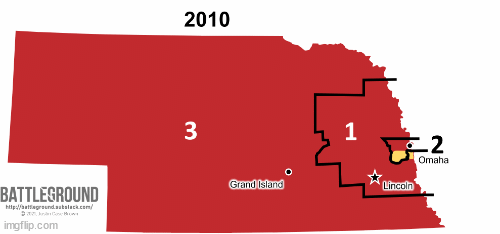Nebraska: Cracked Counties
Neither compactness nor competitiveness were of concern to Nebraska Republicans.
Topline Takeaways
Nebraska’s redistricting process is completely controlled by Republicans as they currently hold power: a majority in the legislature alongside a Republican governor.
The new congressional district map betrays an intent to crack Nebraska’s coalition of Democratic voters as it eschews compactness and increases the number of counties split into multiple districts.
The new NE-02 remains a competitive “Trump-Biden” district and will remain important in presidential elections as Nebraska splits its electoral votes based on congressional district-level wins.
Who’s In Control?
Nebraska’s redistricting process is completely controlled by the state legislature and requires gubernatorial approval before being adopted. Republicans are firmly in the drivers seat here as they hold power: a majority in the state legislature (Nebraska is a unicameral/single-house system.) alongside a Republican governor.
New District Breakdown
The new congressional district map shows a fairly clear intent to crack Nebraska’s coalition of Democratic voters largely found in and around Omaha and Lincoln. This is most obvious in its decision to create serpentine borders that eschew compactness and split two of the state’s counties.
The state’s incredibly rural third district now encompasses 80 of Nebraska’s 93 counties, stealing five counties from the old first district. Many noted the odd decision to move Burt, Washington and Thurston counties from NE-01 to NE-03 as it decreases the compactness of the district and forms a long arm stretching down the western bank of the Missouri River. Even more odd was the decision to create a new county split in Polk (highlighted in yellow at the top), a rural county barely holding 5,000 residents. The northeastern corner of this county now falls in NE-01, while the rest is still represented by rural NE-03. Taken together, these moves signal that map makers were unconcerned with creating compact districts and were instead likely keeping a careful eye on the resulting partisan makeup of the new districts.
One of the most controversial decisions involved wrapping rural Saunders county into the state’s second congressional district rather than including more heavily Democratic Sarpy county in its entirety. The Sarpy county split has long been a sticking point for Nebraska Democrats as many believed it was a clear sign of partisan gerrymandering on behalf of Republicans. The new map creates an even more convoluted divide, snaking along several streets and dividing neighboring communities into separate districts. Despite this attempt to give an edge to Republicans, the new NE-02 remains a competitive Trump-Biden district. It gave Trump a 2-point win in 2016 while handing Biden a 6-point win margin in 2020; voters also split their tickets in 2020 in electing Republican Don Bacon. Ultimately the “blue dot,” as its known locally for its previous support of Obama and Biden in presidential elections, is here to stay as none of the proposed plans would have tilted this seat decisively toward Republicans.




